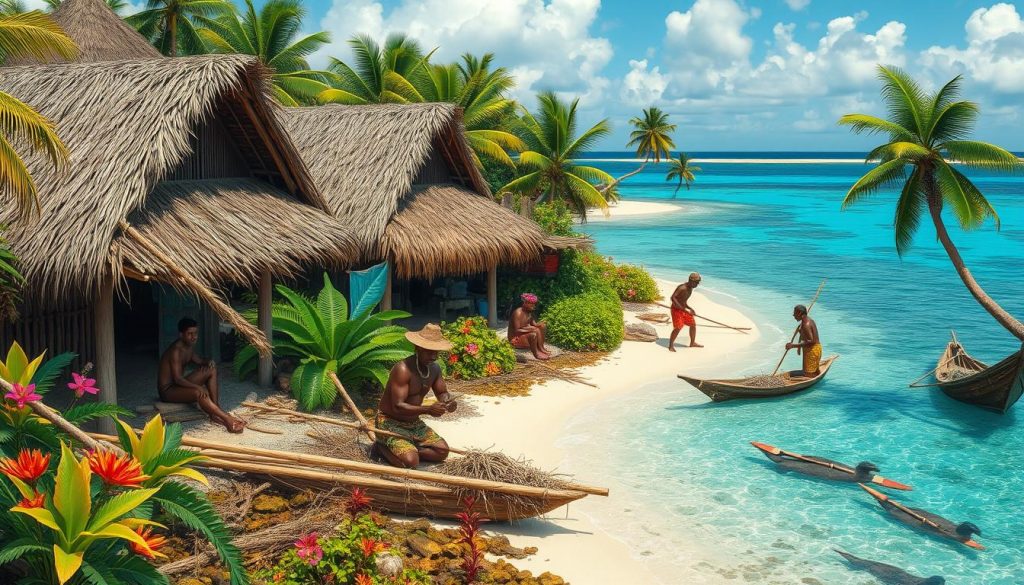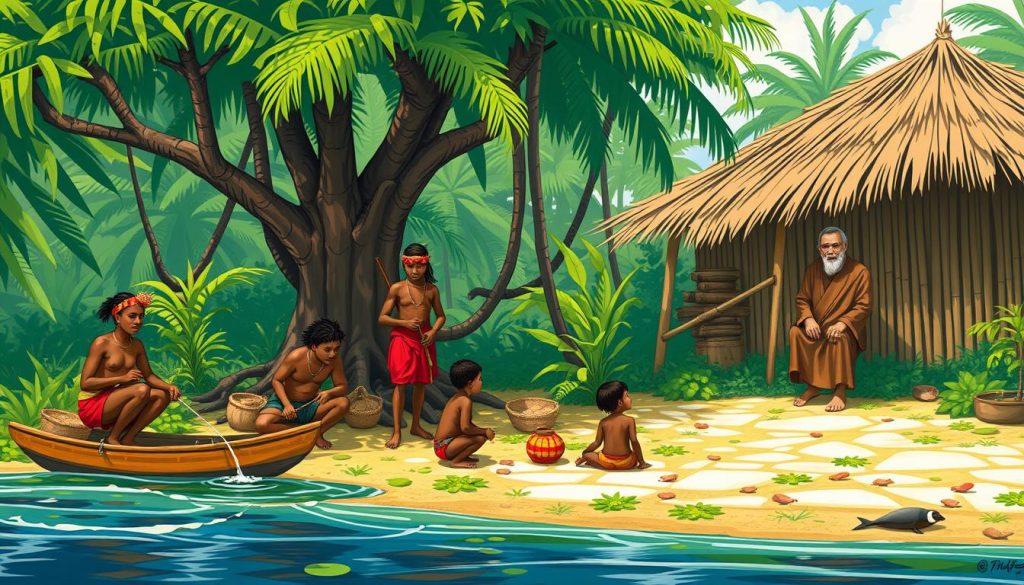The Sentinelese: An Isolated Tribe of North Sentinel Island.
The Sentinelese are known as the most isolated Indigenous peoples in the world. They live on North Sentinel Island, part of the Andaman and Nicobar Islands.
Anúncios
This island is about the size of Manhattan and is untouched by modern life.
The Indian government has made it illegal to contact the Sentinelese. They want to keep their culture and way of life safe. The Sentinelese are very protective and often get angry when outsiders come near.
It’s believed there are between 50 and 200 Sentinelese people. They have lived on the island for over 50,000 years. Their way of life is very different from others around the world.
They live in big huts and temporary shelters. This shows they are good at adapting to their environment. The Sentinelese want to stay independent and keep their identity safe from modern influences.
Anúncios
Introduction to the Sentinelese Tribe
The Sentinelese tribe lives on North Sentinel Island, surrounded by coral reefs and dense forests. Their numbers are unknown, but estimates range from 15 to 500. They are part of the Andamanese indigenous culture and are considered vulnerable by the Indian government.
This tribe mainly eats seafood, fruits, nuts, and small animals. They don’t farm. Their homes are large and simple, with no walls or decorations. They wear little and use javelins and bows for hunting.
The Sentinelese enjoy music, dancing, and celebrations. Some think they might believe in animism, but we don’t know for sure. Their hostility towards outsiders is clear from past tragic events.
The Indian government protects them with strict rules. A three-mile zone keeps outsiders away. This helps keep them safe from diseases they can’t fight off. Since 1967, scientists have tried to learn about them without disturbing them.
| Aspect | Details |
|---|---|
| Population Estimate | 15 to 500, likely between 100 to 300 |
| Diet | Seafood, wild fruits, nuts, small game |
| Housing | Large structures, no side walls |
| Weapons | Javelins, flat bows, arrows |
| Culture | Music, dancing, celebrations |
| Legal Protections | Three-mile exclusion zone established |
History and Isolation of the Sentinelese
The Sentinelese tribe on North Sentinel Island has lived for about 60,000 years. They are one of the most isolated groups in the world. Their isolation has helped them keep a life style like early humans from Africa.
The first mentions of the tribe were in the late 18th century. Trying to make contact with outsiders led to sad events, like in 1879. An elderly couple and children were taken, causing many deaths. These events made the tribe want to stay away from outsiders even more.
In 2004, the tsunami showed the Sentinelese’s strength. They didn’t need help from others. Other tribes, like the Onge and Great Andamanese, lost many people and needed government help. But the Sentinelese stayed healthy and strong.
The Indian government made North Sentinel Island a tribal reserve in 1956. This was to protect the tribe’s right to live alone. The government also made rules, like keeping three nautical miles away from the island and stopping gifts.
There have been important events showing the tribe’s dislike of outsiders. A 27-year-old American’s attempt to contact them ended in death. This showed the risks of trying to reach them. Earlier, like in 1967, TN Pandit tried to make friends, but was met with hostility.
The Sentinelese’s choice to stay isolated shows their strength and ability to adapt. As the world changes, their decision to stay apart reminds us of the importance of respecting and understanding indigenous communities and their freedom.
Culture and Lifestyle of the Sentinelese
The Sentinelese have a rich and diverse *Sentinelese culture*. They live as *hunter-gatherers* on North Sentinel Island. They build temporary huts using materials from their surroundings.
They use narrow outrigger canoes for fishing. Their diet includes wild fruits, crabs, and small game. This shows their deep connection with the land and sea.
They are skilled in using bows and arrows for hunting. Many of these are made with iron from shipwrecks. They also make handcrafted items, showing their artistic side.

Their traditions are both practical and culturally significant. Hunting and tool making are community activities. This way of life is fascinating and untouched by outsiders.
Attempts at Contact with the Sentinelese
Many have tried to reach out to the Sentinelese over the years. These efforts were mainly by anthropologists and outsiders wanting to learn about them. The first time outsiders met the Sentinelese was in 1867 when a ship called the Nineveh crashed near North Sentinel Island. This ship had 106 people on board.
The relationship between the Sentinelese and outsiders has often been tense. In 1880, a British officer took six tribe members, including an elderly couple and four children, by force.
Many attempts to make contact with the Sentinelese have failed. In 1896, a convict who ran away to the island was found dead, shot by arrows. The Indian government started studying the island in 1967, led by anthropologist Triloknath Pandit. His work lasted until 1992, giving some insight into the tribe’s life.
By 1970, India claimed North Sentinel Island. In 1974, a National Geographic team visited, but they were met with hostility. The team was shot at, and the director was hit by an arrow in the thigh. A ship called the Primrose crashed in 1981, leaving 28 sailors stranded for nearly two weeks.
After the 2004 tsunami, the Indian Coast Guard flew over the island. They found that the Sentinelese were not affected by the disaster. However, in 2006, two fishermen were killed by the Sentinelese while they were crabbing near the island. This shows the dangers of trying to make contact with them.
Health and Well-Being of the Sentinelese
The Sentinelese people have lived in isolation for over 50,000 years. This isolation has made them immune to many diseases. They stay healthy, unlike many others around them.
Indian authorities keep an eye on them but rarely interact. This helps keep their way of life pure. It protects them from diseases and keeps them in tune with nature.
Encounters with outsiders have shown how fragile their health is. For example, two Indian fishermen died in 2006. This made people realize the dangers of contact.
There are worries about “gift-dropping” missions. These could bring diseases they can’t fight. It’s a big risk to their health.
In 1969, a report suggested trying to contact them. But now, we just watch from afar. We know diseases could harm them.
Isolated tribes like the Sentinelese are generally healthy. They eat what they find in nature. This keeps them strong, even when food is scarce.
There’s no research on their mental health, but outsiders can stress them out. This can lead to more health problems.
Their isolation is key to their health. It keeps their population strong, around 15 people. This shows a balance between health and isolation.
For more insights into the complexities of interacting with uncontacted tribes, visit this link.
Sentinelese Society and Social Structure
The Sentinelese have a complex social structure. They live in small family units within a community. Their way of life shows a strong focus on family and shared duties.
Living together helps them work together. This is key for survival on North Sentinel Island. Their social structure is built on trust and cooperation.

Their large communal huts show their strong family bonds. Sharing resources is a big part of their lives. This shows how much they rely on each other.
Cooperation is seen in everything they do. From hunting to raising children, unity is crucial. This unity is what keeps them strong in their isolated world.
Even though they keep to themselves, the Sentinelese have a rich culture. They are fiercely protective of their way of life. Their society is built on deep relationships and a strong sense of identity.
| Aspect | Description |
|---|---|
| Population | Estimated around 15 individuals today, a decline from over a hundred decades ago. |
| Living Structures | Large communal huts for family units, indicative of their social framework. |
| Resource Sharing | Collaborative efforts in hunting, gathering, and sustenance. |
| Cultural Characteristics | Emphasis on kinship and community living, critical for survival. |
| Response to Outsiders | Hostility and defense through arrows against intruders. |
Legal Protections and Conservation Efforts
The Indian government has put in place strong laws to protect the Sentinelese and their home, North Sentinel Island. Since 1956, the island is a tribal reserve. This means the rights and way of life of its people are safe.
Rules are strict, and armed patrols keep unwanted visitors away. This shows the government’s dedication to keeping the tribe safe from harm.
Conservation is key in this effort. Groups worldwide work to protect the Sentinelese and the island’s wildlife. The coral reefs around the island are some of the healthiest in the world.
These reefs are home to endangered species like the Andaman wood pigeon. This shows how important the island is for nature.
But, there are dangers. Tourism could bring pollution and harm the island’s balance. It’s important to keep the island safe while respecting the tribe’s wishes.
Controversial Incidents Involving Outsiders
Outsider incidents have long stirred intense discussions around the Sentinelese tribe. These incidents include some tragic and fatal encounters. In 1981, the freighter Primrose ran aground near North Sentinel Island.
An estimated 50 Sentinelese emerged from the jungle, armed with homemade weapons. This incident revealed their fierce defense of territory. It has characterized many of their interactions with outsiders.
Fatal encounters further illustrate the dangers of attempting contact with this isolated group. The death of American missionary John Allen Chau on November 17, 2018, is a stark reminder of these risks. Chau aimed to engage with the tribe and share his beliefs but faced violent resistance.
Before him, in 2006, two men were killed while looking for flotsam. The tribe displayed them, showing their hostile reactions to intrusion.
Attempts at contact have produced mixed results. Historical events since the 1970s, such as a 1974 incident where a National Geographic crew member was shot in the leg with an arrow, highlight the continual threat posed by the Sentinelese. The 1991 contact mission showed a more peaceful side when the tribe received gifts like coconuts without aggression.
However, significant subsequent incidents cast a shadow on the idea of forming connections. The discussion surrounding controversial contact with the Sentinelese evokes ethical considerations regarding uncontacted peoples. The decline of the Great Andamanese population due to outside contact is a concern.
The potential risk of disease exposure for the Sentinelese justifies the strict no-contact policy established by the Indian government in 1994.
Conclusion
The story of the Sentinelese tribe is a powerful reminder of the importance of indigenous rights. With only about 40 people, they are among the last uncontacted tribes. Their way of life is crucial to their identity.
This isolation is not just a choice. It’s a deep expression of their freedom. The Indian government protects them with strict rules, like the Andaman and Nicobar Protection of Aboriginal Tribes Regulation.
Encounters with outsiders have led to sad events, like the deaths of two fishermen in 2006. These incidents show the dangers of trying to contact them. It’s vital to respect their space and way of life.
We must be careful and respectful in any future interactions. This ensures their health, well-being, and freedom. It’s a crucial step for their survival.
Understanding the importance of preserving uncontacted tribes is key. It’s not just about the Sentinelese. It’s about respecting all indigenous cultures. Protecting their rights is essential in our changing world.
